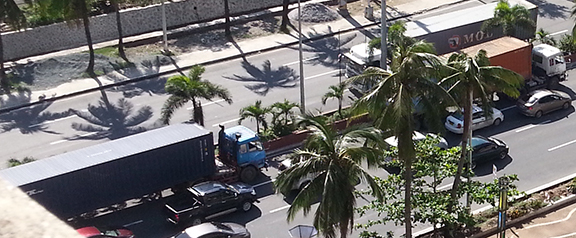 The advisory further extending the suspension of the truck overloading policy is now only awaiting the signature of the transport secretary, but even without the signed moratorium, no truck with codes 12-2 and 12-3 has so far been apprehended for breaking the rule on the maximum allowable gross vehicle weight (GVW).
The advisory further extending the suspension of the truck overloading policy is now only awaiting the signature of the transport secretary, but even without the signed moratorium, no truck with codes 12-2 and 12-3 has so far been apprehended for breaking the rule on the maximum allowable gross vehicle weight (GVW).
According to the Confederation of Truckers Association of the Philippines (CTAP), there have been zero reports of apprehension from their members since the moratorium on the implementing rules and regulations for Republic Act (R.A.) No. 8794—or “An Act Imposing a Motor Vehicle’s Charge on Owners of All Types of Vehicle and for other Purposes”—for trucks with codes 12-2 and 12-3 expired on July 31.
The secretaries of the Department of Public Works and Highways (DPWH) and Department of Transportation and Communications (DOTC) need to sign the advisory to extend anew the moratorium. CTAP director Alberto Suansing earlier said Public Works Secretary Rogelio Singson has already verbally approved the extension of the moratorium for a year or until July 2016.
According to PortCalls sources, Singson has signed the advisory and is only awaiting the signature of Transport Secretary Joseph Emilio Abaya so DPWH can implement the moratorium.
According to CTAP, more than 50% of units nationwide are under codes 12-2 and 12-3, and the only way for truckers to comply with the anti-overloading directive is if the allowable GVW for these codes is upgraded to 54,000 kilograms, higher than the 41,000 kilograms as specified in the revised IRR. A higher GVW, however, requires congressional approval.
Code 12-2 trucks are semi-trailers with three axles on the towing trucks and two axles on the trailer, for a total of 18 wheels, while trucks with the 12-3 configuration are semi-trailers with three axles on the towing vehicle and three axles on the trailer, for a total of 22 wheels.
Under the revised IRR of R.A. 8794, trucks and trailers with these codes that have loads exceeding the prescribed GVW of 41,500 kilograms and 42,000 kilograms, respectively, and load per axle of 13,500 kilograms are considered as overloaded and prohibited from traveling.
CTAP vice president for external affairs Pepito Dino said the most likely reasons for the non-apprehension are lack of awareness among enforcers that the moratorium has expired and fewer deliveries due to low cargo volume.
CTAP directors Suansing and Ruperto Bayocot agreed.
Suansing further noted that due to the low cargo volume and smaller deliveries, some truckers are now having a hard time paying for amortization of new trucks they had imported to comply with the requirement for newer units imposed by the Land Transportation Franchising and Regulatory Board (LTFRB).
LTFRB and its mother agency, the DOTC, have yet to issue a final decision on the proposed 15-year age limit on trucks. Still, truckers with units 15 years and older were earlier disallowed from renewing their franchises under the non-confirmation year policy of LTFRB. But in May, LTFRB struck a compromise to allow those earlier barred from renewing their franchise to file for reconsideration and be permitted to ply the roads again as they await the final decision on the truck age limit proposal. – Roumina Pablo





